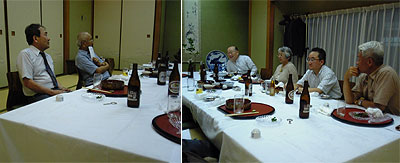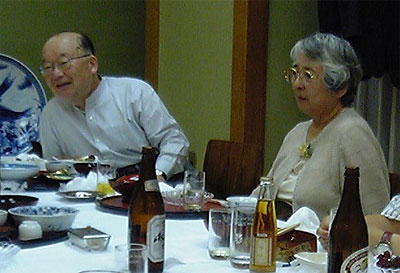• June 30
This is the festival day for Wanuke Shinto God. There is
a jinx on this day, as it always rains. I remember that in the past 30
years it hasn't rained only a few times on the festival day. But today
(the festival day) there has been some clear patches in the sky and it
hasn't rained at all. I almost thought of going to the observatory, as
it turned out to be a beautiful starry evening.
When I passed by the front of the shrine, I saw a large group
of pretty children in red kimono under the torii gate. There were also
tent stalls. I like evening festivals. When young, I used to go to the
shrine wearing summer kimono. The air along the narrow passage to the shrine
was filled with a strong smell of gas lamps and stuffiness created by the
crowds. On the floors of stalls lit by blue gas lamps there were wooden
water basins for a goldfish scooping game. Children's toys, too, were spread
out on the floors. Under the eaves of the stalls were hung many revolving
lanterns projecting dim dream-like images creating the air of fantasy.
Occasionally-heard loud energetic voices and applauds might be from the
sumo wrestling contest at the shrine's sumo ring. The shrine and surrounding
forests were well lit and lively throughout the night.
A friend of mine living in Tokyo bought a telescope-making
kit at a stall of a night festival. This experience stirred his interest
in astronomy and he became an amateur astronomer. Visiting night festivals
used to be quite interesting, as you would always come across unusual articles,
which you would not normally see. However, since about 20 years ago, revolving
lanterns, typical of night stall displays, have disappeared, familiar gas
lamps have been replaced by incandescent lights, energetic sumo matches
have ceased to exist, and tent stalls have been displaying just ordinary
things that you can buy anywhere.
I used to go into a spine-chilling haunted house wearing
summer kimono with a fan in hand. It is now a fading distant memory of
my childhood. I fondly reminisce about the festival nights when I heard
the sounds of flutes and drums from a distant shrine until late at night.
Every year toward the end of summer, the distant sounds of
flutes and drums are sometimes heard at the observatory. It must be from
the festival at a shrine somewhere. They can be heard even past midnight.
Even now, festivals in the countryside seem to be celebrated in the same
way as they have for many many years.
• June 28
There has been no rain at all recently. Weather satellite
images show the clouds off Shikoku caused by a rain front have weakened
and dissipated almost unnoticed. Instead, the front generated the clouds
in the north, ushering in the rainy season to the Tohoku region. This weather
pattern brings moist air from the south into our region making the weather
over Shikoku often unstable. However, we have a clear starry night tonight
with the magnificent Milky Way over Geisei Observatory. Judging from weather
charts, a drought in western Japan will continue. If the rainy season ends
this way, it will be an extremely short rainy season. Water shortages will
be really worrying.
Around August 1955 we experienced water shortages due to
lack of rain. Even the mayor joined in the prayer for rain at Nanatsubuchi
Shrine in Kitayama. The mayor explained: "It's not that I am superstitious,
but I just can't ignore this critical situation." As soon as I returned
home from the prayer, we heard a loud thunder and a downpour followed.
Is it a mere coincidence?
We observed Tempel 1 prior to the rocket's impact on the
comet. The last observation of this comet was made a while ago. The total
magnitude was 11.9 and the coma's diameter was 2'. In spite of its becoming
closer to perihelion, it has faded. It is at the limit of the 20cm telescope's
capacity. The coma of Comet Machholz has also faded and is now invisible.
Yesterday (June 27) Mr. and Mrs. Ichiro Hasegawa, the president
of OAA, visited Kochi City. Five of us living in Kochi gave them a dinner
party. The photographs below are some of the shots of the party taken by
Mr. Shigeo Shimomoto using his cell phone.

From left, Tsutomu Seki, Keiichiro Okamura, Mr. and Mrs. Hasegawa, Messrs
Kenji Muraoka and Akira Kawazoe

A closeup of Mr. and Mrs. Hasegawa
We are supposed to be in the middle of the rainy season,
but have had little rain so far. The rainless rainy season, so to speak.
I remember that I have experienced this sort of weather about three times
since the end of the last war. However, June without rain is beautiful
and pleasant. During the rainy season, we wouldn't usually view the surroundings,
as the rainy weather makes us stay indoors more often. On clear days in
June the lush green vegetation is refreshingly bright and the water of
Kagamigawa River is shining pale blue reflecting the blue sky above. Such
June days are as pleasant as May, when all the plants start growing with
fresh green leaves. It would be great if it brought us fine starry nights,
but more often clouds drift over in the evening and move away unnoticed
in the morning.
The view of Kagamigawa River running through the middle of
Kochi City is beautiful reflecting Mt. Hitsuzan. Kagamigawa River or the
River of Mirror does not mean "a river as clear as a mirror. "
The name comes from the appearance of the river upstream. It makes a loop
resembling the shape of an ancient hand-held mirror. We used to play by
the river and practiced swimming during P.E. classes in elementary school.
Hakushu Kitahara, a respected Japanese poet, wrote the following
children's song:
Over the churning seas lies Sadogashima Island.
Chirp, sparrows, it's becoming dark.
Call out to everybody, you can see a star.
When I was a little child, I would walk about 300 meters
to play on the shore of the river. Around the time when the first star
appeared in the twilight sky, my worried parents would come to take me
home. This was also the river our family escaped to during the terrible
air-raids on July 4, 1945.
Bansui Doi, another famous Japanese lyricist, wrote the school
song of my junior high school. It marvels at the beauty of the natural
environment around Kagamigawa River.
With Mt. Hitsuzan and Kyuko nearby
Our school is blessed with the beauty of nature.
• June 19
The general meeting of Astronomical Society of Shikoku was
held at Geisei Observatory, Kochi, on June 19. The Society is having the
20th anniversary this year. The number of attendees was smaller than expected,
but the founder of the Society, Mr. Yoshihiro Yamada, rushed over from
Kobe to attend it. The meeting ended successfully.
At the end of the meeting I gave the commemorative lecture
titled "40 years since the discovery of Comet Ikeya-Seki." There
was also a tour of the observatory. The 19th of this month is the day when
Comet Ikeya-Seki was discovered and it is Sunday too just like the discovery
day. I talked about the discovery of the comet with the 9cm comet seeker
in my hand, which I had used to discover it. We discussed Comet Denning-Fujikawa,
which is now approaching perihelion. Mr. Kenji Muraoka, who specializes
in orbital calculation, told us about the difficulty in determining this
comet's orbit. After the meeting, some of the attendees drove 40 km west
to my home and enjoyed conversation until late. Nakagawa Observatory and
Geisei Observatory are associated with the Society and we look forward
to their future observational activities.
Astropia, the Society's newsletter, carried in its inaugural
edition a story and photographs related to Japan's first sighting of Halley's
Comet by Geisei Observatory in 1984. There was also a feature story about
our first visit to Subaru Telescope on Hawaii. To commemorate the Society's
20th anniversary, these articles will be put together in one special edition.
I look forward to its publication.



![[Commemorative photo at Geisei Observatory]](Photo/D20050619_1.jpg)
![[A tour of Geisei Observatory]](Photo/D20050619_2.jpg)
![[The Milky Way over Geisei before the onset of the rainy season]](Photo/D20050609.jpg)